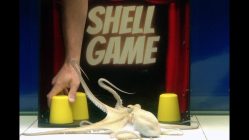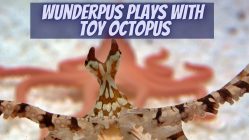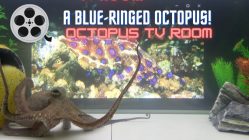
The North Atlantic Octopus was initially described by Danish biologist Ferdinand Victor Alphons Prosch back in 1849. It is a small-sized octopus which occurs in the deep and cold waters of the Atlantic Ocean. It stands out from the crowd for its very long brooding period and its even longer lifespan.
North Atlantic Octopus Facts
- Scientific Name : Bathypolypus Articus
- Common Name: North Atlantic Octopus, Deep Sea Octopus, Spoonarm Octopus
- Size: 6-10 cm (2.4–3.9 in)
- Weight: up to 300 g
- Lifespan: 6 years
- Found in: North Atlantic
- Sub-Order: Incirrina
- Discovered: 1849
- Scientific Name : Bathypolypus Articus
- Common Name: North Atlantic Octopus, Deep Sea Octopus, Spoonarm Octopus
- Size: 6-10 cm (2.4–3.9 in)
- Weight: up to 300 g
- Lifespan: 6 years
- Found in: North Atlantic
- Sub-Order: Incirrina
- Discovered: 1849
The North Atlantic Octopus is a deep-sea species with a very long brooding period and record-breaking lifespan
—Distribution and Habitat—

The North Atlantic Octopus, as its name suggests, is a resident of the Atlantic Ocean. It can be found both in the western Atlantic (from the Florida Straits up to Greenland) and in the eastern Atlantic (from the north of Russia down to Spain).
As a deep-sea species, it generally resides at a depth range of 200 to 600 m (660–1,970 ft), although it has been detected both in shallower and deeper waters, and at a maximum depth of 1,543 m (5,062 ft).
The temperature in these depths ranges between 2 and 6 °C (36–43 °F). The North Atlantic Octopus, therefore, prefers temperate to polar waters. It can not survive temperatures above 10 °C (50 °F) although scientists managed to keep specimens alive at 11 °C (52 °F) by slowly acclimating them to the higher temperature.
Scientists presume that the North Atlantic Octopus prefers sandy or muddy bottoms.
—Physical Attributes—

The North Atlantic Octopus is distinctively different from other species as its head is more circular and less ovoid. It is a small-sized octopus that could fit into your palm.
Its arms are short and irregular, with their tips often curled up. The hectocotylus of the North Atlantic Octopus has a much larger, spoon-shaped ligula and that is why another name for this species is the Spoonarm Octopus.
Being a deep-sea species, the North Atlantic Octopus does not need an ink sac.
Its body is covered in warts, with two more prominent ones above its large eyes.
—Live Slow, Die Old—

One sad fact about our eight-arm friends is that they have a very short lifespan. Most species live for a maximum of two years, and usually not more than one. That is why people often say that octopuses live fast and die young. Laying a lot of eggs is a mechanism that ensures the continuation of the species.
However, not all species are the same. To name one example, the Giant Pacific Octopus is a species which is known for its much longer lifespan.
The North Atlantic Octopus is a species that lives slower and dies a bit older as well. Recent studies have confirmed that this octopus can survive for six years or even more, and not only for 3 years as it was previously believed.
Lifespan depends highly on water temperature. Lower water temperature decreases the growth rate of this species, but results in a longer lifespan.
Deep sea species like the North Atlantic Octopus are not so active as shallow-water octopuses, therefore consuming less energy. Prey is also more difficult to come by in the abyss. Luckily, the North Atlantic Octopus can survive many days without feeding.
—Second Best Brooder—

The North Atlantic Octopus lays relatively fewer eggs than most species. During a study, females were observed to lay between 12 and 105 eggs.
This species used to be famous for its very long brooding period of over 400 days. This record was recently broken by another species known as Graneledone boreopacifica, another deep sea resident which was observed brooding her eggs for 53 months! That is actually a record brooding period in the entire animal kingdom!
Another fact about female octopuses is that they stop eating after laying their eggs. However, the North Atlantic Octopus has been observed to feed from time to time in order to survive the long brooding period.
One might think that laying fewer eggs would result in a decrease of the species population. But the longer brooding period means that when the young hatch, they are already big enough to skip the planktonic stage and become immediately benthic. In this way, the fewer hatchlings have better chances of survival than the hundreds of offspring produced by shallow-water species.
—Lonely Hearts—

Finding a suitable mate in the vastness of the abyss might prove a big challenge for a small octopus species such as the North Atlantic Octopus. A longer brooding period and larger-sized hatchlings is only one of the few adaptations that contribute to the species’ survival.
Other adaptations include the male’s larger ligula and the female’s ability to store the sperm inside her body for approximately 5 months.
No wonder why when scientists attempted to keep North Atlantic Octopuses in the same aquarium, they did not become aggressive or cannibalistic, as it is the case with most octopus species. They were probably glad to finally have some company!
—Not Suitable As a Pet—
Even if there was one chance (which is highly improbable) of coming across a North Atlantic Octopus, you should not consider adopting it as a pet for a very practical reason.
Even researchers have had a very difficult time studying this deep-sea species. Keeping the water temperature steady between 2 and 6 °C (36–43 °F) is a challenge. Even if you don’t mind the cost of the equipment and energy needed, you would still need to be prepared for the possibility of a power cut.
So unless you are a resident of the North or South Pole, you should probably consider another species for adoption.











